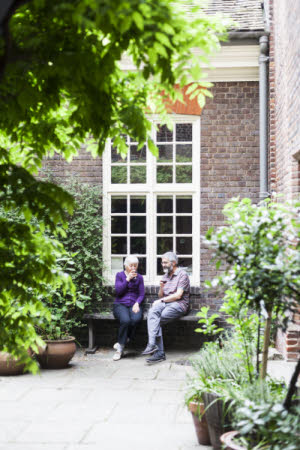Set in Hackney, Sutton House is a rare example of brick Tudor, which comes complete with oak-paneled rooms, original fireplaces and arches. It is a miracle that is has survived intact, from five centuries of urban development.
It's astonishing to find this house tucked away in Hackney, opposite a council estate. Built in 1535, when Hackney was a small village surrounded by fields but only three miles from Bishopsate, it was an attractive place for a rich man to build his house. But as the area became less and less desirable and the house ended up looking like a complete dump, it's a miracle it wasn't demolished. The house clearly underwent numerous modifications before eventually being more or less abandoned in the 1990s when most of the fine interior's fittings (carved wooden panelling, fireplaces etc) had been ripped out and sold and the inner court yard and garden had been buried under rubbish.
Today the house has been painstakingly restored by the National Trust and although the facade is clearly Georgian, the interior has some outstanding Tudor features such as the wooden pannelling in almost every room. In the cellar you can see the original brickwork, which makes the building unique because most houses were built in wattle and daub at that time.
The history of Ralph Sadler (who built the house) is equally fascinating. He was brought up from 11 years old in the household of Oliver Cromwell and later became his secretary. He then served Henry VIII, becoming Privy Councillor, Secretary of State and then ambassador for Anglo-Scottish relations. Sadler also served Edward VI, although having helped devise the Act which settled the crown on Jane Grey, he had to make himself scarce during the reign of the catholic Queen Mary I. But during the reign of Elizabeth I, he made a come back to serve as a Privy Councillor and becoming responsible, once again for Anglo-Scottish diplomacy. He died at the age of 85, (in 1587), the richest commoner in England.
The name of the house and the type of occupant has never stopped changing: from the Bryk Place to the Blue House, and finally to Sutton House. The house has been occupied over the ages by merchants, sea captains and Huguenot silk-weavers. It has been used both as a boys’ school and a girls’ school. During World War II it was used by fire a brigade, who surveyed fires from the roof. In the 60s it was rented by a trade union, which abandoned it in the early 80s, to squatters who finally left in 1982, adding their own artistic expression to the building, which you can still see today.
TheSave Sutton House Campaign was formed in March 1987 to rescue the building and open it to the public in 1991.
As well as delving into the past as you wander through the house, you can drink tea in the café, visit the gallery, and find a bargain in the second-hand bookshop. Throughout the year, there are lots of different events. As well as meeting Father Christmas each Christmas, you can also stock up with presents at the Christmas market or watch Beauty and the Beast at the Tea Break Theatre.
Sutton House
2 & 4 Homerton High St, London E9 6JQ
Opening Times
The opening times are restricted, and if you would like to schedule a weekend tour, please contact Sutton House to set up a time.
Historic rooms, gallery, café and shop: 12:00-17:00

- Monday:
-
12:00 - 17:00
- Tuesday:
-
12:00 - 17:00
- Wednesday:
-
12:00 - 17:00
- Thursday:
-
12:00 - 17:00
- Friday:
-
12:00 - 17:00
- Saturday:
- Closed
- Sunday:
- Closed




